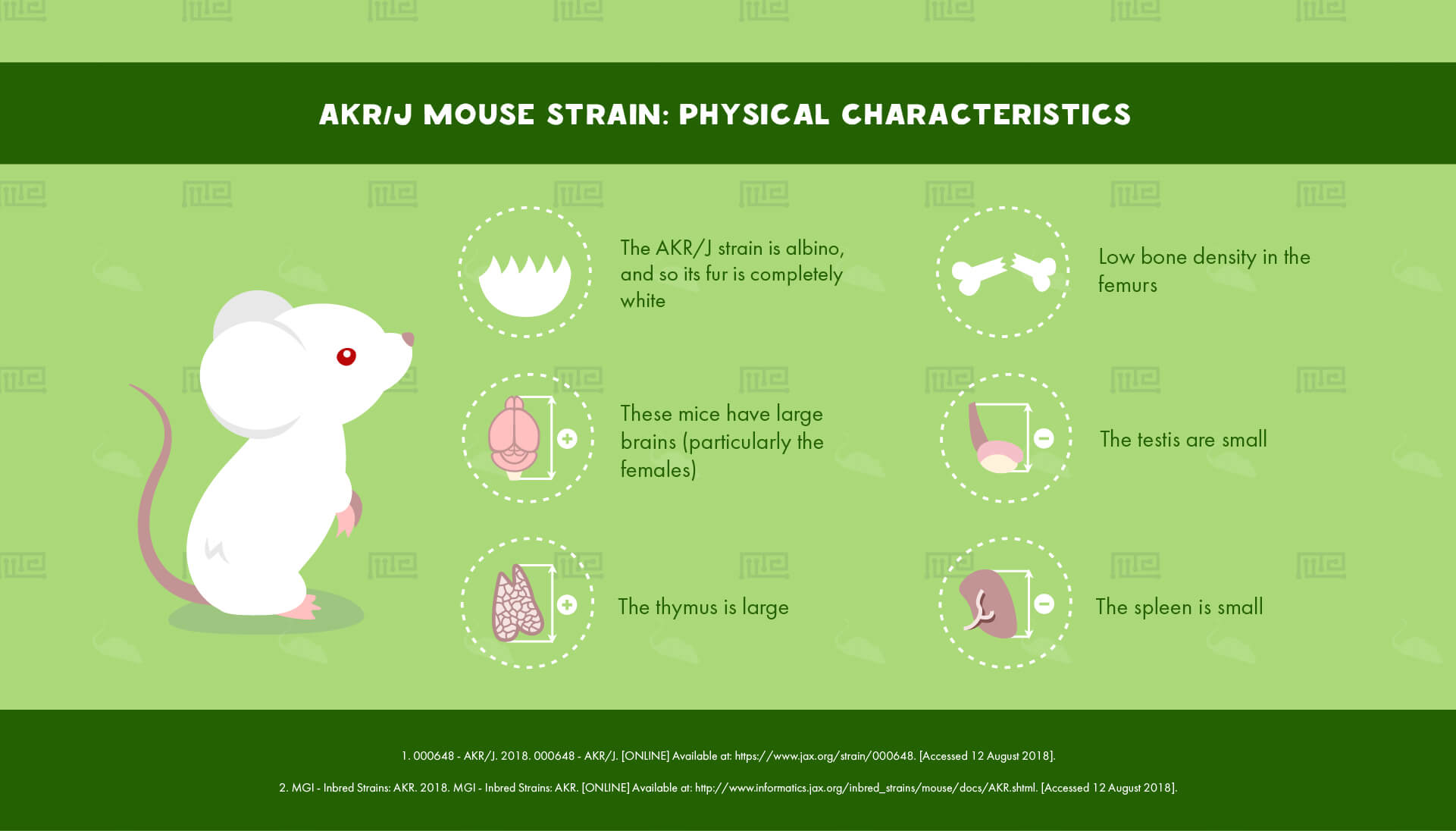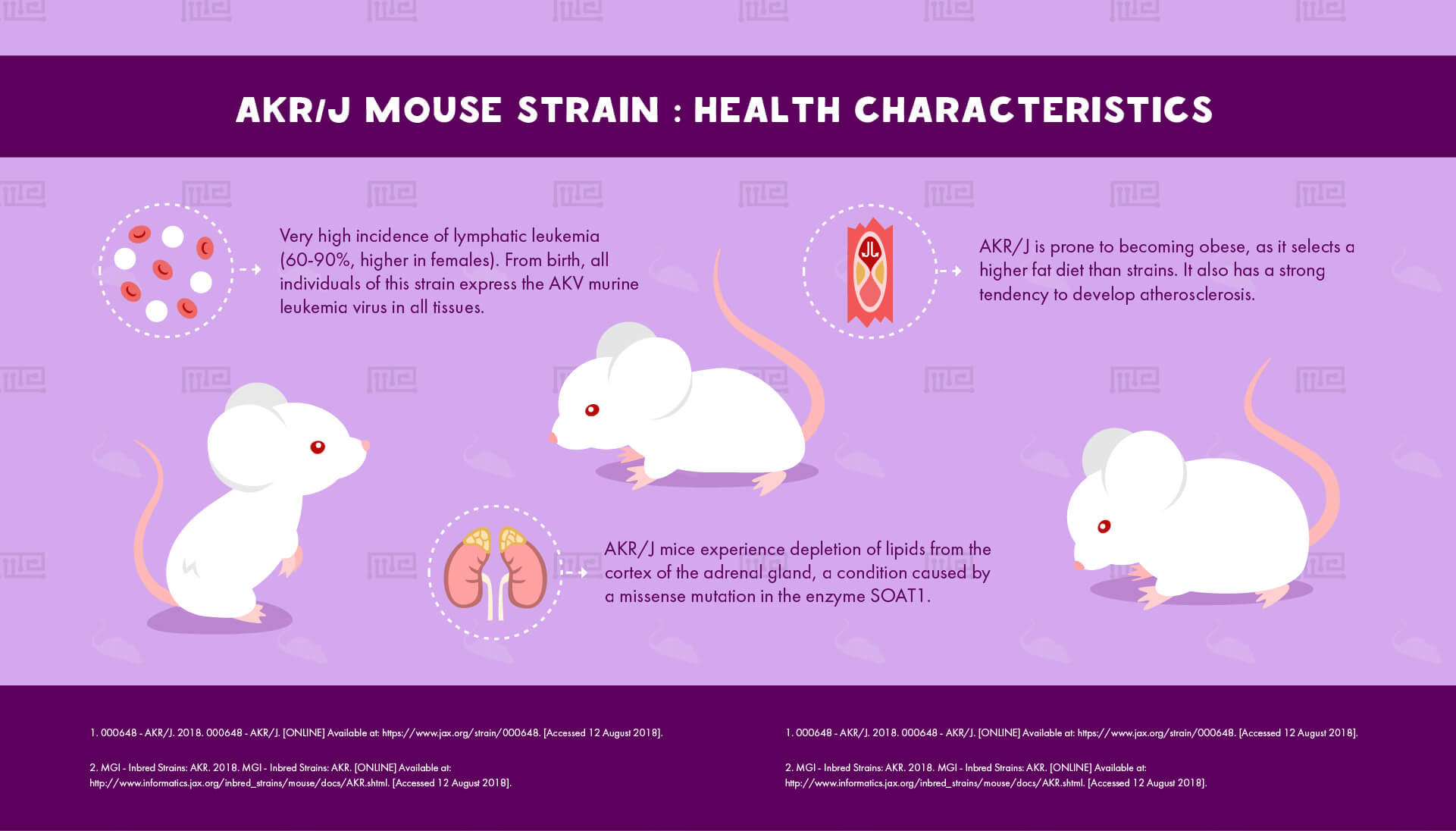AKR/J mice are an inbred, albino strain of mouse model that is frequently used in cancer research, due to their very strong propensity to develop leukemia.
History
The original AKR mouse strain was descended from mice sold by a dealer Philadelphia, USA, sometime in the 1920s. These mice were bred by Furth in the late 1920s/early 1930s to become a strain with a high incidence of leukemia.
The mice passed to the Rockefeller Institute in the late 1930s. The AKR/J substrain, maintained by the Jackson Laboratory, was created in the 1940s. Use of AKR/J has spread globally, and it is now the eighth most commonly used mouse strain.[1][2]
Physical Characteristics
The AKR/J strain is albino, and so its fur is completely white. These mice have large brains (particularly the females), a large thymus, small testes, a small spleen, and low bone density in the femurs. They express a mutant hid gene (hair interior defect), whose effects on their fur can only be seen under a microscope.[1][2]
Behavioral Characteristics & Handling
One study describes the AKR/J strain as aggressive.[3] This is corroborated by a Canadian study[4] of comparative ease of handling by strain, which rated AKR/J mice lowest for placidity out of the 21 featured strains. AKR/J also exhibited the highest squeak frequency when held, and showed some struggling, although the initial capture of the mice was reported as relatively easy. Researchers would be advised to be cautious when handling this strain.
AKR/J mice have also been described as exhibiting “low emotionality”.[2] One study[5] reports high immobility for these mice in the forced swimming test, indicating possible depressive mood. Observations of high open field activity[2] suggest that the immobility in the forced swimming test is a mood issue and not a locomotive one. This is further supported by an apparent low preference for sweet substances, indicating anhedonia.[2]
Intermediate breeding performance but low reproductive performance, with small litter sizes, are reported for this strain.[2]
Health Characteristics
The most notable health characteristic of the AKR/J strain is its very high incidence of lymphatic leukemia (60-90%, higher in females). [1][2][6] From birth, all individuals of this strain express the AKV murine leukemia virus in all tissues. Subsequently, their average lifespan is short: about a year for a male and eight months for a female.[1][2]
AKR/J mice experience depletion of lipids from the cortex of the adrenal gland, a condition caused by a missense mutation in the enzyme SOAT1.[1] Like the more commonly used DBA/2J and C57BL/6J strains, AKR/J is prone to becoming obese, as it selects a higher fat diet than strains such as BALB/cJ.[7] It also has a strong tendency to develop atherosclerosis.[2]
Major Experimental Uses
AKR/J mice were selectively bred for use in cancer research, and that remains their major application today.[1][6] This strain is also used in immunology for the generation of the theta AKR antigen,[6] in cardiovascular research on atherosclerosis, developmental research on lymphatic system defects, diabetes and obesity research, adrenal gland disorders, and metabolic research on enzyme deficiency.[1]
References
- 000648 – AKR/J. 2018. 000648 – AKR/J. [ONLINE] Available at: https://www.jax.org/strain/000648. [Accessed 12 August 2018].
- MGI – Inbred Strains: AKR. 2018. MGI – Inbred Strains: AKR. [ONLINE] Available at: http://www.informatics.jax.org/inbred_strains/mouse/docs/AKR.shtml. [Accessed 12 August 2018].
- Southwick C. H. and Clark L. H. (1966) Aggressive behavior and exploratory activity in fourteen mouse strains. Zool. 6, 559.
- Wahlsten, D. Metten, P. Crabbe, JC. 2003. A rating scale for the wildness and ease of handling laboratory mice: results for 21 inbred strains tested in two laboratories. Genes, Brain and Behavior. 2; 71-79.
- Nikulina E. M., Skrinskaya J. A., and Popova N. K. (1991) Role of genotype and dopamine receptors in behavior of inbred mice in a forced swimming test. 105, 525-529.
- EMBL-EBI Ontology Lookup Service. 2018. AKR/J. [ONLINE] Available at: https://www.ebi.ac.uk/ols/ontologies/efo/terms?short_form=EFO_0007726. [Accessed 12 August 2018].
- Alexander J, Chang GQ, Dourmashkin JT, Leibowitz SF. Distinct phenotypes of obesity-prone AKR/J, DBA2J and C57BL/6J mice compared to control strains. Int J Obes (Lond). 2006 Jan;30(1):50-9.


